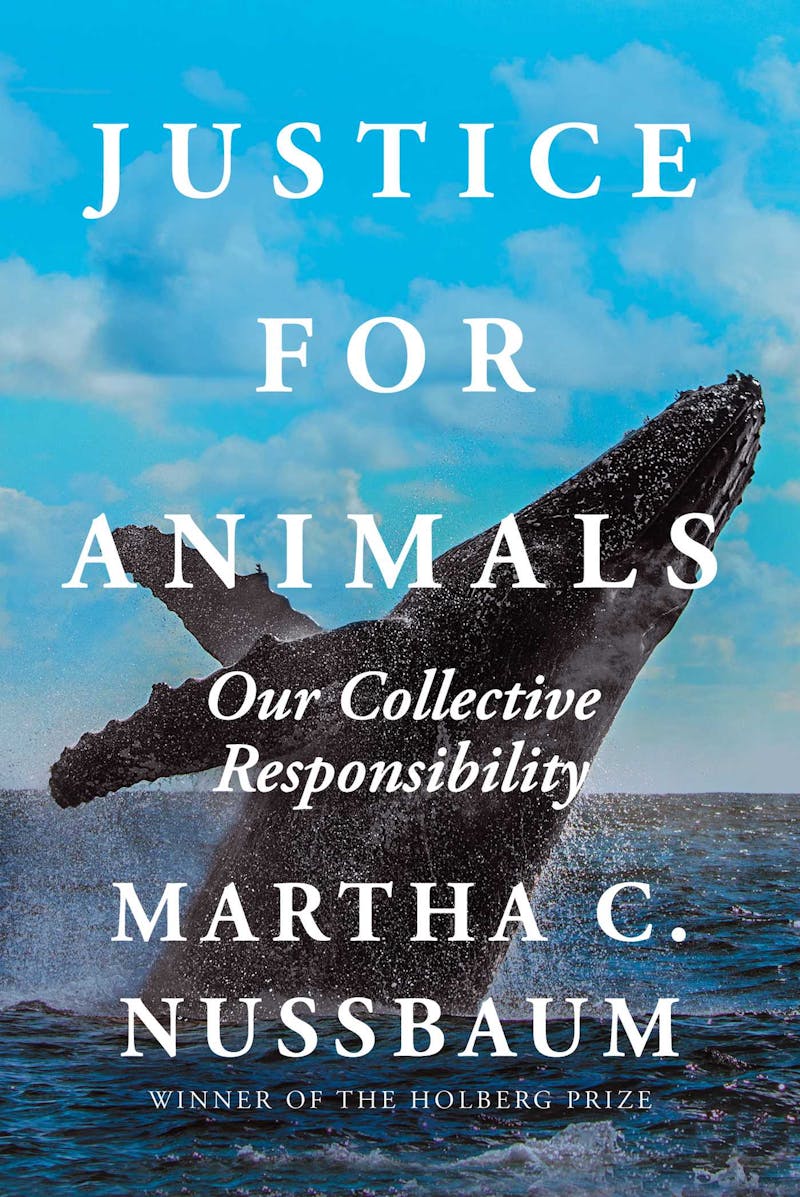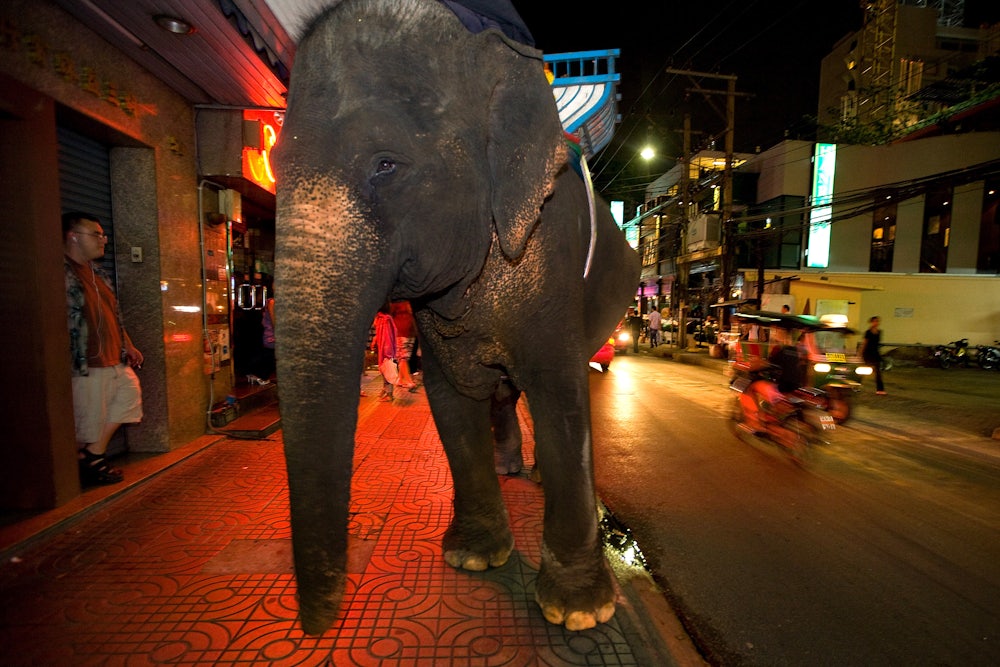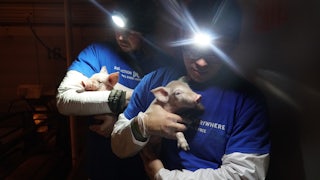The numbers say it all: Nearly two-thirds of global mammalian biomass is currently made up of livestock, the majority raised and killed in intolerably cruel factory farms. The domesticated chicken is now the world’s most populous bird, whose discarded bones will define the fossil record of our human-dominated age. Driven by habitat loss, climate change, and other human causes, the ongoing Sixth Mass Extinction represents not just a crisis of biodiversity but a source of immense suffering for millions of individual creatures.
“Animals are in trouble all over the world,” University of Chicago professor Martha Nussbaum writes in Justice for Animals: Our Collective Responsibility, her new book out this month. In her half-century as a moral philosopher, Nussbaum has tackled an enormous range of topics, including death, aging, friendship, emotions, feminism, and much more. But this book, which Nussbaum dedicates to her late daughter, an animal rights lawyer who passed suddenly in 2019, wades into new territory: What is justice for animals?

Nussbaum believes this question has been poorly theorized philosophically and a practically nonexistent concern in politics and law. During our conversation, which has been edited for length and clarity, Nussbaum and I discussed the limitations of common philosophical approaches to animals, what her approach offers that other dominant theories of animal justice do not, and why she sees herself as a “liberal reformist with a revolutionary streak.”
Jack McCordick: You’re putting forward a new theory of animal justice. What did you find missing from the approaches people have taken to this subject before?
Martha Nussbaum: The first of them I call the “So Like Us” approach, which has been developed by Steven Wise and his Nonhuman Rights Project. His idea is that you should ask judges to treat certain animals as persons under law on the grounds of their likeness to humans. The problem with this approach is that, first, it does absolutely nothing for the vast majority of animals who are not deemed sufficiently like us. All the animals in the factory farming industry, and all kinds of other animals who receive horrible treatment, are left with no legal protection. Second, likeness to us is just not a good reason to treat a being well or poorly. Third, it’s just inaccurate in terms of the natural world, because there’s not a series of hierarchical steps. There’s tremendous horizontal diversity and variety, as there ought to be, because each creature has evolved in a separate ecological niche, and each has the abilities that are suited to that niche. We should look and see the marvelous variety in nature and not think about higher and lower.
The second theory is utilitarian theory, originated by Jeremy Bentham in the late eighteenth century and continued today by Peter Singer, one of the great animal defenders around. This theory argues that pain is the great bad thing in nature and pleasure is the great good thing. If we only ended all wrongfully inflicted pain in animal lives, that would certainly be tremendous progress.
But there are so many different things that are important in animal lives. Animals do need freedom from pain, but they also need community of species-specific types. They need a lot of room to move around. They need play and recreation. The thing that I don’t like about utilitarianism is that while I talk about creatures leading a life, utilitarianism focuses on a passive state of satisfaction. It doesn’t make room for agency. But living beings don’t want to just be put in a state of satisfaction. They want to be active architects of their own lives.
J.M.: Your book also addresses the argument that philosopher Christine Korsgaard makes in her book Fellow Creatures that we must treat creatures as ends, not simply as means, even as she maintains that humans are distinct from animals in terms of the capacity for ethical reciprocity and moral reflection.
M.N.: Animals are what she calls “passive citizens”: They receive the benefits of good treatment if they get it, but they aren’t active architects of the treatment they get now.
I think that’s both empirically and normatively wrong. Plenty of other animals have deliberative abilities of various kinds and social-normative abilities of various kinds. Think about apes. The behavioral ecologist Frances White has for 30 years been describing the complex normative cultures of chimpanzees and bonobos, showing how they negotiate conflict and how they treat the young and teach them norms. And this happens not only for apes. We’ve learned that elephants mourn their dead with communal rituals of grief. We’ve learned so much about birds’ complicated normative systems. We could go on and on about this. Many kinds of animals have complex normative cultures.
The other thing that we’ve learned is that this is not just genetic. It’s taught. There are lots of animals for whom scientists used to think all behavior was genetic. But now we know that in a very large number of cases these abilities are socially learned. We can see now how whales teach young whales the norms of whale culture. This makes them seem much more complicated.
And of course, when we get to the companion animals that we live with, we observe how they learn norms, they internalize norms, and they know when they’re violating them.
Second, it’s also just not a good reason for saying that you can’t participate in legislation. Animals express in marvelously active ways—through vocalism and also through gestures and behavior—what they want and what is meaningful to them. Why shouldn’t they be active citizens in the sense that their indications are taken very seriously when laws are made?
J.M.: What do you think your approach offers to a theory of animal justice?
M.N.: What Amartya Sen and I thought when we dreamed up the Capabilities Approach is that the basic question that ought to be asked in the human realm is, What are people actually able to do and to be? Capabilities doesn’t mean skills; it means the space for choice. We ask what capabilities people have, meaning what possible lives are open to them, and then we look at different areas in which people are affected by policy, such as life, health, bodily integrity, and so on. What I did was to turn this into a theory of basic justice for humans that could be used for constitution-making. We can say that humans are living in a just society when the society makes it possible for them to have a minimal threshold level of 10 central capabilities that I then made a list of.
The 10 core capabilities I laid out are the ones that seem to be important for humans. But for each animal, there are things that are important to that type of animal. So my idea was that the theory of justice for animals would contain many different lists of central capabilities for each type of animal, and that an animal would be treated with minimal justice if it’s put above a reasonable threshold for the central capabilities for its kind. It turns out there’s a lot of overlap, because we’re all animals trying to live in a rather difficult world. The large, general things on my list—including life, health, bodily integrity, the use of senses, thought, imagination, emotion affiliation, play, control over your environment—are really common to humans and animals.
But when we get further down into the nitty gritty of each species, there are tremendous differences. What a human needs in order to have a social and affiliative life is quite different from what an elephant needs. An elephant needs a matriarchal herd, which then allows the males to go off as loners and meet up with the herd from time to time. Dolphins need a large pod of some 35 to 40 other dolphins. And so on.
Affiliation takes many forms. Some animals are loners. When we look at each kind of animal, we need to have people who know that kind of animal very well and who are trustworthy reporters. That is now possible because scientists have lived with animals in such sensitive ways. There are people who have lived with baboons for years and years. There are people who have lived with elephants for years and years. It’s harder for marine mammals because of course we can’t go and live with them in the same way, but there are great scientists who spend their whole lives studying each type of whale and dolphin. So we have this information, and we’ll get more and more information as time goes on.
The core of my argument is when those characteristic life activities are wrongfully curtailed, that is injustice, and we should move to correct it. To give one example of something that judges have already done: In 2016, a U.S. Navy sonar program was declared illegal under a law called the Marine Mammal Protection Act because it adversely impacted the life activities of whales. The sonar noise cuts into their space, and the whales turned out to have heightened stress hormones, delayed reproduction, and delayed migration. The opinion lists all these things and then it says these are adverse impacts. It’s very striking because other courts have not said that because they were looking for evidence of physical pain. There isn’t any physical pain, but there are these other incursions into a characteristic life activity. So that’s the kind of thing that should be illegal. Of course, it’s easier when you’re dealing with coastal waters, where American law governs or another country’s law can govern. It’s much more difficult than the deep seas. But that is the kind of thing that the law should say.
J.M.: The law and courts are so central to the argument here. What would you want lawyers, judges, people who are working in the legal system to have in mind as they think about all the various injustices that animals are subject to?
M.N.: The more localized you are, the easier it is to make progress. With local ordinances, everyone can get involved. The puppy mill industry has been terminated in Chicago. That is, people who breed these dogs in substandard conditions have been stopped from doing that, and they’ve been stopped by the vigilance of local politicians in Chicago. Now that doesn’t stop them from breeding those dogs and selling them some other place. And that’s the defect of local organizations. It has to be replicated in every place where people live. The state of Missouri, where the most puppy mills are, has been unwilling to rein it in.
Of the laws that are on the books, the Animal Welfare Act is actually an excellent law. The Migratory Bird Treaty Act is an excellent law, and the Marine Mammal Protection Act. None of them cover animals that we eat because of course the industry blocks that.
So we have to focus, I think, first of all on getting laws that limit the factory farming industry, and I think that’s doable, but one way you can do it is by regulations on the sales of their products. So now we pretty much have regulated non–cage free eggs out of existence—or at least it’s happening pretty rapidly. California was the first to insist that any eggs sold in California would have to be cage free, but now other states are doing that, and I think pretty soon it’s going to happen all over the country.
The meat industry is much more difficult. But I think incrementally we can get more and more regulation of that industry, and we can gradually get to a point where we would have adequate protections for the welfare of the animals who are raised.
J.M.: In the book, you describe yourself as a “liberal reformist with a revolutionary streak.” Can you explain what you mean and how that applies to what you believe must be done to achieve justice for animals?
M.N.: What I mean is that I don’t want to hector people and lecture them and make them feel bad if they don’t do everything perfectly. You shouldn’t let the perfect be the enemy of the good. There are some people and some books in the animal realm that even make me feel guilty because I don’t do everything according to some strict vegan norm. I want to include everyone who’s troubled by the way animals are treated and who wants to offer some help. Even though we might disagree about some things, everyone can agree that the factory farming industry is intolerably cruel and should be stopped right away. It should be abolished.






